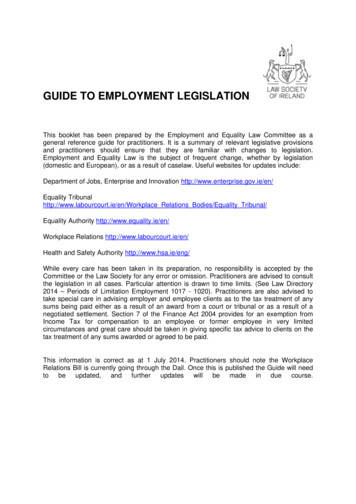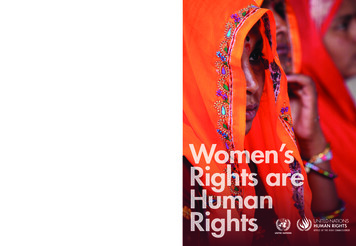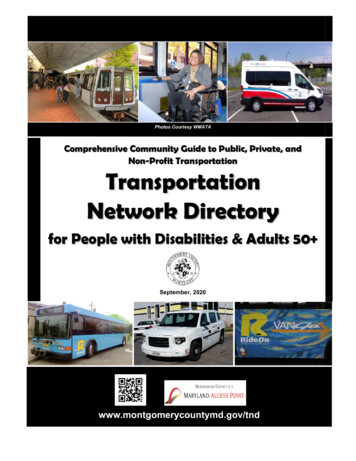
Transcription
GUIDANCEYour Rightsto Equality at Work:Working Hours,Flexible Workingand Time OffEquality Act 2010 Guidance forEmployeesVolume 2 of 6Equality and Human Rights Commissionwww.equalityhumanrights.com
Your Rights to Equality at Work: Working Hours, Flexible Working and Time OffContentsIntroduction . 5Other guides and alternative formats . 5The legal status of this guidance. 6What’s in this guide? . 6What else is in this guide? . 71 Your rights not to be discriminated against at work:what this means for how your employer must behave towards you. 8Are you a worker? . 8Protected characteristics . 8What is unlawful discrimination? . 9Situations where equality law is different . 12Positive action . 14Treating disabled workers better than non-disabled workers . 14Public sector equality duty and human rights . 14What’s next in this guide . 15Decisions about hours of work and flexible working. 16Avoiding direct and indirect discrimination . 18Reasonable adjustments to remove barriers for disabled workersand avoiding discrimination arising from disability . 21Requests for changes to hours of work or flexible workingon the basis of association with a protected characteristic . 22Requests for changes to hours of work or flexible workingrelating to religion or belief . 23Requests for changes to hours of work or flexible workingrelating to gender reassignment. 24A helpful approach for your employer to take . 25Decisions relating to time off . 26Direct and indirect discrimination . 27Reasonable adjustments to remove barriers for disabled workersand avoiding discrimination arising from disability . 29Requests for time off relating to religion or belief . 31Equality and Human Rights Commission · www.equalityhumanrights.comUpdated December 20142
Your Rights to Equality at Work: Working Hours, Flexible Working and Time OffRequests for time off relating to gender reassignment. 31Pregnancy-related absences . 32Maternity, paternity, adoption and parental leave . 34Fertility treatment . 352 When your employer is responsible for what other people do . 36When your employer can be held legally responsible forsomeone else’s unlawful discrimination, harassment or victimisation . 37How your employer can reduce the risk that they will be heldlegally responsible . 38When your employer’s workers or agents may be personally liable. 38What happens if the discrimination is done by a person whois not your employer’s worker or agent . 39What happens if a person instructs someone else to do somethingthat is against equality law . 40What happens if a person helps someone else to do somethingthat is against equality law . 40What happens if an employer tries to stop equality law applyingto a situation. 413 The employer’s duty to make reasonable adjustmentsto remove barriers for disabled people . 42Which disabled people does the duty apply to? . 44How can your employer find out if you are a dis abled person? . 44The three requirements of the duty . 45Are you at a substantial disadvantage as a disabled person? . 46Changes to policies and the way an organisation usually does things. 47Dealing with physical barriers . 47Providing extra equipment or aids. 48Making sure an adjustment is effective . 49Who pays for reasonable adjustments? . 49What is meant by ‘reasonable’ . 50Reasonable adjustments in practice . 52Specific situations . 584 What to do if you believe you’ve been discriminated against . 60Your choices . 61Was what happened against equality law? . 62Ways you can try to get your employer to s ort out the situationEquality and Human Rights Commission · www.equalityhumanrights.comUpdated December 20143
Your Rights to Equality at Work: Working Hours, Flexible Working and Time Offby complaining directly to them . 63Monitoring the outcome . 67The questions procedure . 67Key points about dis crimination cases in a work situation . 69Where claims are brought . 69Time limits for bringing a claim. 70The standard and burden of proof. 72What the Employment Tribunal can order the employer to do . 72Settling a dispute . 74Agreement between you and the employer . 74Where to find out more about making a tribunal claim . 765 Further sources of information and advice . 77Glossary . 86Contacts . 104Equality and Human Rights Commission · www.equalityhumanrights.comUpdated December 20144
Your Rights to Equality at Work: Working Hours, Flexible Working and Time OffIntroductionThis guide is one of a series written by the Equality and Human Rights Commissionto explain your rights under equality law. These guides support the introduction ofthe Equality Act 2010. This Act brings together lots of different equality laws, many ofwhich we have had for a long time. By doing this, the Act makes equality law simplerand easier to understand.There are six guides giving advice on your rights under equality law when you are atwork, whether you are an employee or in another legal relationship to the person ororganisation you are working for. The guides look at the following work situations:1. When you apply for a job2. Working hours and time off3. Pay and benefits4. Promotion, transfer, training and development5. When you are being managed6. Dismissal, redundancy, retirement and after you’ve leftOther guides and alternative formatsWe have also produced: A separate series of guides which explain your rights in relation to people andorganisations providing services, carrying out public functions or running anassociation. Different guides explaining the responsibilities people and organisations have ifthey are employing people to work for them or if they are providing services,carrying out public functions or running an association. If you require this guide inan alternative format and/or language please contact us to discuss your needs.Contact details are available at the end of the publication.Equality and Human Rights Commission · www.equalityhumanrights.comUpdated December 20145
Your Rights to Equality at Work: Working Hours, Flexible Working and Time OffThe legal status of this guidanceThis guidance applies to England, Scotland and Wales. It has been aligned with theCodes of Practice on Employment and on Equal Pay. Following this guidance shouldhave the same effect as following the Codes and may help employers and othersavoid an adverse decision by a court or tribunal in proceedings brought under theEquality Act 2010.This guide is based on equality law as it is at 6 April 2014. Any future changes in thelaw will be reflected in further editions.This guide was last updated in April 2014. You should check with the Equality andHuman Rights Commission if it has been replaced by a more recent version.What’s in this guide?If your employer is making decisions about the hours you work, whether you canwork flexibly or have time off, equality law applies to what they are doing.Equality law applies: whatever the size of the organisation whatever sector you work in whether your employer has one worker or ten or hundreds or thousands whether or not your employer uses any formal processes or forms to help themmake decisions.This guide tells you what your employer must do to avoid all the different types ofunlawful discrimination. It recognises that smaller and larger employers may operatewith different levels of formality, but makes it clear how equality law applies toeveryone, and what this means for the way every employer (and anyone who worksfor them) must do things.It covers the following situations and subjects (we tell you what any unusual wordsmean as we go along): Decisions about hours of work and flexible working-Avoiding direct and indirect discrimination-Making reasonable adjustments to remove barriers for disabled people andavoiding discrimination arising from disabilityEquality and Human Rights Commission · www.equalityhumanrights.comUpdated December 20146
Your Rights to Equality at Work: Working Hours, Flexible Working and Time Off -Requests for changes to hours of work or flexible working on the basis ofassociation with a protected characteristic-Requests for changes to hours of work or flexible working relating to aworker’s religion or belief-Requests for changes to hours of work or flexible working relating to aworker’s gender reassignmentDecisions relating to time off-Avoiding direct and indirect discrimination-The specific age exception allowing different levels of annual leave based onlength of service of up to five years-Reasonable adjustments to remove barriers for disabled people and avoidingdiscrimination arising from disability-Requests for time off relating to religion or belief-Requests for time off relating to gender reassignmentPregnancy-related absences-Sickness absence-Ante-natal careMaternity, paternity, adoption and parental leaveWhat else is in this guide?This guide also contains the following sections, which are similar in each guide in theseries, and contain information you are likely to need to understand what we tell youabout working hours, flexible working and time off: Information about when an employer is responsible for what other people do,such as workers employed by them. Information about reasonable adjustments to remove barriers if you are adisabled person. Advice on what to do if you believe you’ve been discriminated against. A Glossary containing a list of words and key ideas you need to understand thisguide– all words highlighted in bold are in this list. They are highlighted the firsttime they are used in each section and sometimes on subsequent occasions.These words are explained further in the glossary. Information on where to findmore advice and support.Equality and Human Rights Commission · www.equalityhumanrights.comUpdated December 20147
Your Rights to Equality at Work: Working Hours, Flexible Working and Time Off1 Your rights not to bediscriminated against at work:what this means for how youremployer must behavetowards youAre you a worker?This guide calls you a worker if you are working for someone else (who this guidecalls your employer) in a work situation. Most situations are covered, even if youdon’t have a written contract of employment or if you are a contract worker ratherthan a worker directly employed by your employer. Other types of worker such astrainees, apprentices and business partners are also covered. Sometimes,equality law only applies to particular types of worker, such as employees, and wemake it clear if this is the case.Protected characteristicsMake sure you know what is meant by: age disability gender reassignment marriage and civil partnership pregnancy and maternity race religion or beliefContinued Equality and Human Rights Commission · www.equalityhumanrights.comUpdated December 20148
Your Rights to Equality at Work: Working Hours, Flexible Working and Time Off sex sexual orientation.These are known as protected characteristics.What is unlawful discrimination?Unlawful discrimination can take a number of different forms: Your employer must not treat you worse than another worker because of aprotected characteristic (this is called direct discrimination).Example — An employer is considering two requests for flexible working fromworkers who do not qualify for the statutory employment right to request flexibleworking. One worker is a Christian and the other is not. The employer decidesto agree only to the Christian’s request, believing they will use the time in amore worthwhile way. This will probably be direct discrimination against the nonChristian because of religion or belief. The correct approach is for the employerto consider the requests by looking at the impact of the proposed workingpattern on the organisation, and not at the protected characteristics of theperson making the request. This may or may not lead to the same result, but thedecision would not have been made because of the protected characteristic ofreligion or belief, so neither worker would have a claim for unlawfuldiscrimination because of their religion or belief.- If you are a woman who is pregnant or on maternity leave, the test is notwhether you are treated worse than someone else, but whether you aretreated unfavourably from the time you tell your employer you are pregnantto the end of your maternity leave (which equality law calls the protectedperiod) because of your pregnancy or a related illness or because ofmaternity leave.Your employer must not do something which has (or would have) a worse impacton you and on other people who share your particular protected characteristicthan on people who do not have that characteristic. Unless your employer canshow that what they have done, or intend to do, is objectively justified, this willbe indirect discrimination. ‘Doing something’ can include making a decision, orapplying a rule or way of doing things.Equality and Human Rights Commission · www.equalityhumanrights.comUpdated December 20149
Your Rights to Equality at Work: Working Hours, Flexible Working and Time Off If you are a disabled person, your employer must not treat you unfavourablybecause of something connected to your disability where they cannot show thatwhat they are doing is objectively justified. This only applies if an employerknows or could reasonably have been expected to know that you are a disabledperson. The required knowledge is of the facts of the worker’s disability but anemployer does not also need to realise that those particular facts are likely tomeet the legal definition of disability. This is called discrimination arising fromdisability.Example — An employer insists that all workers have to be in the office by 9amor face disciplinary action. A worker has a mobility impairment that makestravelling in the rush hour difficult. Unless the employer can objectively justifythe requirement to be in at that time, this may be discrimination arising fromdisability, because the disabled worker would be treated unfavourably (beingdisciplined) for something connected to their disability (the inability to travel inthe rush hour).This may also be a failure to make reasonable adjustments. Your employer must not treat you worse than another worker because you areassociated with a person who has a protected characteristic.Example — An employer allows all staff with children to leave work early oneafternoon before Christmas to attend their children’s school play or show. Theyassume that a worker with a disabled child will not need this time off so do notgive them the same concession. This is likely to be direct discriminationbecause of disability on the basis of the worker’s association with their disabledchild. Your employer must not treat you worse than another worker because theyincorrectly think you have a protected characteristic (perception). Your employer must not treat you badly or victimise you because you havecomplained about discrimination or helped someone else complain or doneanything to uphold your own or someone else’s equality law rights.Example — When a worker asks to work flexibly, their employer refusesbecause the worker helped a colleague with a complaint about discrimination.This is almost certainly victimisation.Equality and Human Rights Commission · www.equalityhumanrights.comUpdated December 201410
Your Rights to Equality at Work: Working Hours, Flexible Working and Time Off Your employer must not harass you.Example — A worker is given permission by their manager to take annual leavebut only after offensive questioning related to their sexual orientation which hasmade them feel humiliated. This is likely to be harassment. In addition, if you are a disabled worker, to make sure that you have the sameaccess to everything that is involved in doing a job (including flexible working andtime off) as a non-disabled worker, your employer must make reasonableadjustments.Example — An employer has a written policy which covers all types of leave,including what to do if workers are too ill to come to work, how decisions will bemade about when annual leave is taken, and on flexible working. As areasonable adjustment for a disabled worker who has a visual impairment, theemployer reads the policy onto a CD and gives it to the worker. Your employer must make reasonable adjustments to what they do as well as theway that they do it.Example — A worker who has a learning disability has a contract to work from9am to 5.30pm but wishes to change these hours. This is because the friendwho accompanies the worker to work is no longer available before 9am.Allowing the worker to start later is likely to be a reasonable adjustment for thatemployer to make.You can read more about reasonable adjustments to remove barriers fordisabled people in Chapter 3.You must not be discriminated against in the ways described above even after youremployment relationship with them ends if what they are doing arises out of and isclosely connected to the employment relationship that you had with them.Equality and Human Rights Commission · www.equalityhumanrights.comUpdated December 201411
Your Rights to Equality at Work: Working Hours, Flexible Working and Time OffSituations where equality law is differentSometimes there are situations where equality law applies differently. This guiderefers to these as exceptions.There are two exceptions which are relevant to decisions about working hours,flexible work and time off. These apply to all employers: The possibility that direct age discrimination can be objectively justified. Special treatment for women in connection with pregnancy and maternity.We only list the exceptions that apply to the situations covered in this guide. Thereare more exceptions which apply in other situations, for example, when anemployer is recruiting someone to do a job. These are explained in the relevantguide in the series.In addition to these exceptions, equality law allows your employer to: Treat disabled people better than non-disabled people. Use voluntary positive action in the way workers are managed. While positiveaction is most often seen as applying in recruitment, promotion and training, it canalso be helpful in addressing workers’ different needs when managing them.AgeAge is different from other protected characteristics. If they can show that it isobjectively justified, your employer can make a decision based on someone’s age,even if this would otherwise be direct discrimination. . However, there are onlylimited situations in which direct age discrimination will be objectively justified.To show that something is objectively justified, your employer must be able toshow that there is a good reason for doing what they are doing and that what theyare doing is proportionate.When you are the subject of direct age discrimination your employer is only allowedto rely on a limited number of reasons. These are generally those that would be inthe wider public interest, like promoting access to employment for younger people orpreserving the dignity of older workers as opposed to reasons particular to theirbusiness. Even if there is a good reason, your employer’s actions must still beproportionate.The test is not quite the same as for indirect discrimination. This is because forindirect discrimination your employer is allowed to rely on any reason for wanting toEquality and Human Rights Commission · www.equalityhumanrights.comUpdated December 201412
Your Rights to Equality at Work: Working Hours, Flexible Working and Time Offmake a decision or apply a rule provided it represents a real objective considerationand it is proportionate.There is a specific age exception allowing different levels of benefits, eg annualleave based on length of service of up to five years.Since the abolition of the default retirement age of 65 in 2011, employers seeking toimpose a retirement age for their employees must now objectively justify theirdecision to do so. You can find more information about this in our guidance, Yourrights to equality at work: dismissal, redundancy, retirement and after you have lefta job.Special treatment in connection with pregnancy and maternityIt is not sex discrimination against a man to provide special treatment for a woman inconnection with pregnancy or childbirth.Example — An employer allows a pregnant worker to have time off not just forante-natal appointments (which is a legal requirement) but also to attend fitnessclasses for pregnant women at a nearby gym. The worker makes up the lost hoursat another time, which she would not have to do for an ante-natal appointment. Itwould not be sex discrimination to refuse a man’s request to go to a fitness classduring working hours.However, when granting special treatment to a woman who has already given birth,the treatment must be a proportionate means of compensating a woman for thedisadvantages occasioned by her being pregnant or having given birth. In otherwords, any special treatment cannot be too remote from the fact that the woman hashad a baby. It will usually be proportionate to continue any benefits that the womanhas received as part of her employment for the whole of the maternity leave period,and other steps may be required to ensure that she is not disadvantaged because ofabsence due to pregnancy or maternity leave. If it is possible this should be done ina way that does not disadvantage another worker, though, sometimes, preferentialtreatment, even where this results in a disadvantage to another worker, will benecessary. As long as any special treatment does not go beyond what is necessaryto rectify her disadvantage, it will not be sex discrimination against a man.Equality and Human Rights Commission · www.equalityhumanrights.comUpdated December 201413
Your Rights to Equality at Work: Working Hours, Flexible Working and Time OffPositive action‘Positive action’ means the steps that your employer can take to address thedifferent needs or past track record of disadvantage or low participation of peoplewho share a particular protected characteristic.Although most often thought of in the context of recruitment, promotion or training,positive action is available to your employer in all employment situations, althoughthey have to go through a number of tests to show that positive action is needed.Taking positive action is voluntary. Your employer does not have to take positiveaction. However: Meeting the different needs of the workforce can help make staff more productive. If an employer is a public authority, positive action may help them meet thepublic sector equality duty.If you want to know more about what it might mean for you if your employer takesvoluntary positive action in relation to how they manage you and their other workers,read the Equality and Human Rights Commission’s guide: Your rights to equality atwork: how you are managed.Treating disabled workers better than non-disabled workersAs well as these exceptions, equality law allows an employer to treat a disabledworker better – or more favourably – than a non-disabled worker. This can be doneeven if the disabled worker is not at a specific disadvantage because of theirdisability in the particular situation. The reason the law was designed this way is torecognise that in general disabled people face a lot of barriers to participating in workand other activities.Public sector equality duty and human rightsPublic sector employers must have what the law calls ‘due regard’ to the need toeliminate the types of conduct which are prohibited under the Equality Act 2010discussed in this guide and to advance equality of opportunity and foster goodrelations between those who have particular protected characteristics and those whodon’t. This is called the ‘public sector equality duty’. Other bodies who carry outEquality and Human Rights Commission · www.equalityhumanrights.comUpdated December 201414
Your Rights to Equality at Work: Working Hours, Flexible Working and Time Offpublic functions on behalf of public authorities also have to comply with the publicsector equality duty, in relation to those particular functions.The three aims of the duty apply to all protected characteristics apart from marriageand civil partnership, which is only relevant to the first aim (eliminatingdiscrimination). Thus a body subject to the duty must have due regard to the need toeliminate discrimination where it is prohibited under the Equality Act 2010 because ofmarriage or civil partnership in the context of employment.Some public authorities are also subject to what are known as specific equalityduties. These require specific steps which are designed to assist relevant authoritiesin the performance of the public sector equality duty. These specific duties aredifferent in England, Scotland and Wales.In addition, public sector employers will be required to comply with the Human RightsAct 1998 and their employees may have rights against them under the Act.Further information about the public sector equality duties and the Human Rights Actis available from the Equality and Human Rights Commission.What’s next in this guide?The next part of this guide tells you more about how your employer can avoid all thedifferent types of unlawful discrimination in the following situations: Decisions about hours of work and flexible working-Avoiding direct and indirect discrimination-Reasonable adjustments to remove barriers for disabled people and avoidingdiscrimination arising from disability-Requests for changes to hours of work or flexible working on the basis ofassociation with a protected characteristic-Requests for changes to hours of work or flexible working relating to religionor belief-Requests for changes to hours of work or flexible working relating to genderreassignment-A helpful approach for your employer to takeDecisions relating t
trainees, apprentices and business partners are also covered. Sometimes, equality law only applies to particular types of worker, such as employees, and we make it clear if this is the case. Protected characteristics Make sure you know what is meant by: age disabili










